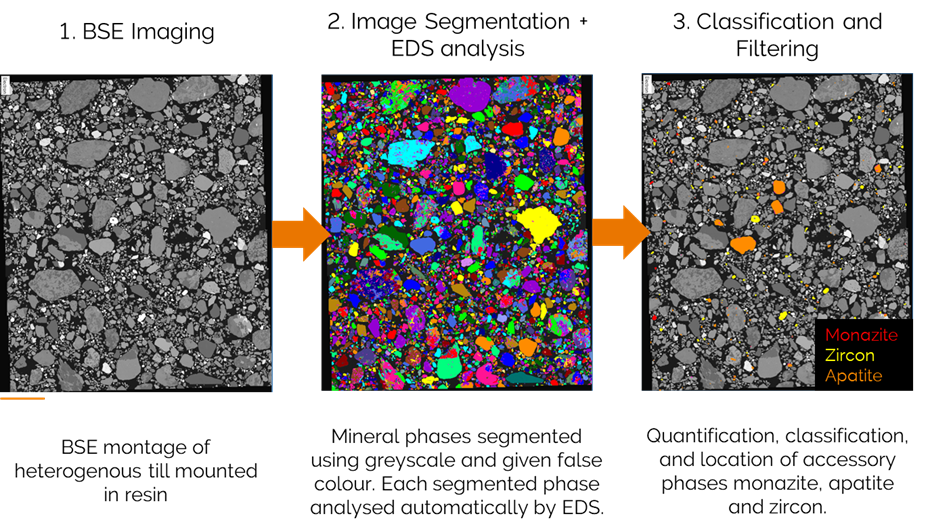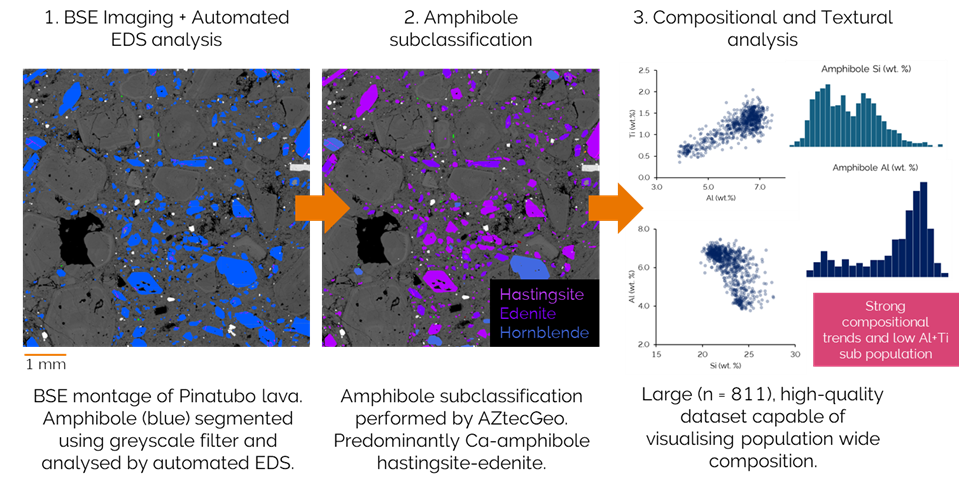Struggling with Mineral Classification for Automated SEM Analysis? There’s a Better Way!
Ever found yourself stuck in the tedious process of building and optimising a mineral classification scheme for automated mineral analysis on an SEM? If so, you’re not alone. In my experience, geoscientists looking to perform automated mineralogy often spend a significant amount of time using a light microscope and combing through online databases to determine the theoretical composition of minerals in their samples. There has to be an easier way, right?
Well, good news! Today’s blog introduces AZtecGeo, a geoscience-dedicated user profile for AZtecFeature. Designed to streamline the workflow, its goal is simple; to help acquire high-quality morphology and composition data while accelerating the translation of elemental information into mineralogy.
Particle Analysis and Automated Mineralogy
Since the early 2000s, electron microscopists and geoscientists have been working together to refine automated workflows for characterizing whole-sample mineralogy. The result? Automated mineralogy—a game-changing approach that applies a particle analysis workflow to streamline mineral characterisation.
At its core, this method segments an electron image based on greyscale, identifying features of specific greyscale values for compositional analysis using energy-dispersive X-ray spectroscopy (EDS). This technique offers several major advantages:
• Insight – Automated mineralogy delivers real-time, high-precision data on both morphology (e.g., grain size) and mineralogy (e.g., composition and abundance)
• Autonomy – The EDS acquisition process is self-guided, freeing up user time and enabling overnight or multi-day analyses. The only real limitation is the chamber size - an automated run could last for days!
• Speed – When dealing with large numbers of particles (>100) with variable compositions, this is by far the fastest way to acquire EDS data. The electron beam moves at an astonishing speed, characterising up to 120,000 particles per hour - a rate impossible to achieve with manual analysis.

With these capabilities, geology focussed particle analysis has transformed the way we study geological samples, offering efficiency, accuracy, and scalability like never before.
Beyond Mining: The Expanding Role of Geological particle analysis
Initially adopted by the mining industry, particle analysis revolutionised ore deposit assessment by providing geospatial insights into key economic factors. Speed was essential—not just for efficiency, but because mining operations require mineral characterisation at scales ranging from metres to kilometres. Any unnoticed variations in the ore feed to a processing plant could significantly impact mineral recovery and, ultimately, profitability.
However, word has spread across the geoscience community, and this powerful technique has been repurposed for a wide range of applications, including:
• Petroleum Reservoir Assessment – Quantifies key properties such as grain size, porosity, and mineralogy, essential for evaluating reservoir quality
• CO₂ Sequestration – Helps assess mineral reactions, porosity, and grain size to predict the long-term stability of CO₂ injection sites
• Mineral Exploration – Rapidly detects trace minerals that signal potential economic mineralisation in detrital samples
• Petrology – Provides precise mineral composition and texture data, informing studies across metamorphic, igneous, and sedimentary geology
• Accessory Mineral Studies – Quickly identifies and maps rare but geologically significant accessory phases for targeted follow-up analysis.
The impact of automated mineral characterisation extends far beyond mining. If you need quantitative, high-throughput assessment of texture and mineralogy across multiple samples, this technique is an invaluable tool.
How can AZtecGeo Help?
AZtecGeo is a dedicated user profile
designed for mineral characterization within the particle analysis software AZtecFeature. It comes packed with features aimed at simplifying analytical setup, ensuring high-quality data collection, and accelerating mineral classification.
Here’s what makes AZtecGeo stand out:
• Built-in Mineral Classification Scheme – Access a preloaded library of over 200 common rock-forming minerals, reducing the need to manually search online databases for theoretical compositions. This allows users to create new classification schemes faster and more efficiently.
• Preset Image and EDS Acquisition Settings – Collect high-quality data in the shortest possible time with recommended settings for magnification, image resolution, EDS target count rate, and process time. Even if you’re not an expert microscopist, AZtecGeo helps optimise your methodology with ease.
• Guidance and Support at Every Step – The workflow includes detailed ‘step notes’ written by experts, providing instant explanations for each stage of the setup process. These have been specifically tailored for geomaterial analysis, making AZtecGeo accessible to all geoscientists.
• World-Leading Particle Analysis – As part of AZtecFeature, AZtecGeo benefits from its fast, accurate, and intelligent particle analysis. The software can process up to 120,000 particles per hour and extract precise compositional data with user-defined counting statistics.
While automated mineralogy has strong ties to mineral processing, we’re positioning AZtecGeo as a versatile tool for broader geoscience applications in AZtecFeature. For users seeking a dedicated automated mineralogy platform, we offer AZtecMineral.
AZtecGeo in Practice
To demonstrate the power of this solution, I’ve put together two short case studies showing how high-quality mineral characterisation can be achieved in real time across large and diverse samples.
All data was collected using a Zeiss Gemini 460 electron microscope equipped with a single Ultim Max ∞ 100 mm² EDS detector. Analyses were performed in AZtec 6.2, using both AZtecFeature and AZtecGeo for efficient and accurate mineral classification.
The Hunt for Accessory Phases
When it comes to geological insight, some minerals are far more valuable than others. Geoscientists often focus on specific, compositionally variable mineral phases that can reveal key geological processes or physical characteristics. Take zircon, for example—its uranium and lead content is commonly used to date magmatic rocks, providing crucial insights into Earth's history.
The Application: Till is the material left behind by melting glaciers. Since glaciers are highly destructive and cover vast areas, till contains a diverse mix of rock fragments from the underlying terrain. Among these fragments, accessory minerals can serve as indicators of hidden mineral resources and provide clues about the provenance of detrital minerals, a process known as vectoring.
The Problem: By definition, accessory minerals are rare, often tiny, and sometimes absent altogether, making their detection a challenge. It’s a classic "needle in a haystack" problem. Even when they are present, identifying multiple suitable targets for follow-up correlative analysis—such as BEX, EBSD, or Raman—can be difficult.
Our Solution: We conducted a full characterisation of an epoxy-mounted till sample to assess the presence of geologically significant accessory minerals. Using BSE greyscale thresholds, we segmented all mineral phases, eliminating epoxy from the analysis and breaking down composite particles. This approach allowed for precise identification of key mineral phases, providing a powerful solution for detecting and analysing rare accessory minerals.

In just 45 minutes, over 10,000 mineral particles were analysed, with a minimum of 20,000 counts acquired and processed per feature. This rapid yet detailed approach allows for efficient classification and filtering of key mineral phases, such as monazite, apatite, and zircon, directly from the data table.
With stage coordinates stored for each field, targeted phases can be easily relocated for further correlative analysis, using techniques like BEX, EDS, Raman, or EBSD. Alternatively, a large-area map (as shown above) can be exported to guide analyses on a separate system, ensuring smooth integration with additional workflows.
Assessing Population-Wide Mineral Chemistry
Petrologists often rely on abundant mineral phases to reconstruct the geological environments in which rocks formed. Magmatic amphibole, for example, is particularly valuable as it records temperature and pressure conditions at the time of crystallisation. By analysing a broad population of amphiboles, geochemists can uncover geochemical trends and cryptic processes that influence volcanic systems.
The Application: Volcanic systems often exhibit wide variations in mineral compositions, particularly within amphiboles. Many of these systems contain distinct sub-populations of crystals that provide insight into key geological processes, such as magma mixing. Identifying and characterising these variations is essential for understanding the evolution of volcanic environments.
The Problem: Manually analysing amphibole populations using the traditional "point and ID" method is time consuming, requiring a large number of analyses to accurately capture chemical variability. Additionally, user-guided analysis introduces the risk of cognitive bias, potentially skewing results and limiting the reliability of interpretations.
Our Solution: To overcome these challenges, we implemented a strict threshold filter to isolate amphiboles and exclude all other materials, such as glass and non-target minerals (see image).
This approach allowed for the rapid analysis of 800 amphibole grains in just 15 minutes, generating a robust dataset that accurately represents the mineral population.
By streamlining amphibole characterisation, this method not only saves time but also enhances data accuracy, offering a powerful tool for petrologists studying volcanic processes.

By setting a minimum count threshold of 30,000 per feature, we ensured the reliable detection of minor constituents, such as Na and Ti, even at concentrations below 2 wt.%. This level of precision is crucial for distinguishing subtle compositional variations within the amphibole population.
Using AZtecGeo’s automatic subclassification, we identified a dominant composition of hastingsite and edenite, with minor occurrences of hornblende. The broader population exhibited a bimodal distribution of Si, Al, and Ti, which was immediately visualised within AZtec or through exported compositional data (see above).
This clustering suggests the presence of two homogenised amphibole populations, potentially reflecting distinct batches of magma that later mingled. Such insights provide valuable context for understanding the magmatic history recorded in these minerals.
Wrap Up
AZtecGeo brings a new level of efficiency and precision to geoscience-focused particle analysis in AZtecFeature. Built on leading technology, it simplifies analytical setup while delivering fast, reliable mineral quantification and classification.
For geoscientists working with large, heterogeneous samples, AZtecGeo provides a powerful solution to rapidly assess mineral morphology and composition. By streamlining complex workflows and enhancing data accuracy, it opens the door to deeper geological insights with much less effort.
Whether you're CO2 reservoirs, hunting for accessory phases, or conducting high-resolution petrological research, AZtecGeo is designed to help you get the most out of AZtecFeature—quickly and confidently.





